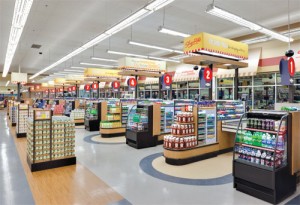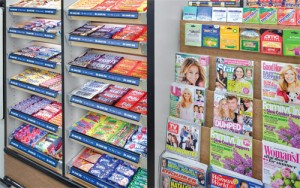I never realized that the placement of products on the shelves in the stores could lead to obesity and generate huge profits for companies before I read Anh’s blog and her linked website. However, when I recalled all my shopping experience, I found out “yes,” most grocery stores place snacks bins beside the check-out counters and use those bins’ eye-catching positions and consumer psychology to sell more merchandise and earn profit.
According to the study sponsire d by Mars, Coca-Cola and Time Warner about impulse sales, they found out that 1% of the whole supermarket sales was genenrated from check-out lane sales. And candy sales occupies 30% of sales following by magazines and drinks.
d by Mars, Coca-Cola and Time Warner about impulse sales, they found out that 1% of the whole supermarket sales was genenrated from check-out lane sales. And candy sales occupies 30% of sales following by magazines and drinks.
When consumers are waiting for checking out, they are bored and easily attracted by little eye-catching things around them. Because of those “targets” have less value and small volume, most consumers are impelled by impulse to buy them they actually don’t need which cause a waste of resources, the increased rate of obesity by eating too much candys and shopping regret.
In order to better catch this goldern oppotunity, most retailers behave in the same way: 1. Carry confectionary on all check-out lanes 2. Maximize magazines presentence —browsing by consumers to generate more puchasing oppotunities. 3. Locate beverage coolers as much as possible in each checkout lanes.

When most grocery stores carry on this marketing strategy, the self-checkout lanes’ emergence largely deducts the chance of consumers’ impulse purchase because of the space limit.
However, we cannot judge whether this is good or not because when we look from seller’s point of view, even though they lose some oppotunies of impulse sales, they make checkout process become more efficient and convenient. For customers, they decrease the risks of shopping regret, wasting money and other negative effects through impulse purchase.
Reference: Classmate “Anh Tran”s blog: https://blogs.ubc.ca/anhtran/

I strong agree the placement of products will make consumers spend more but I doubt the possibility of causing obesity. You are not shopping everyday and how can a maybe once a week ice cream bar leads to obesity? Even for those who do daily grocery shopping, if they get ice cream or candies ever time when they are lining up at the cashier, they would remember to get a big box of those products next time they shop, rht? I also think the placement strategy is mutually beneficial. Not only the retailer increase their sales but also the customers gain convenience as well..
That’s only one reason for obesity. You can click on the link above and in that page, you can find a survey and results to state how that impulse sales causing obesity. Also, this whole blog is mostly about impulse sale– a type of consumer behaviour. As for your comments on the convenience for the consumers, I think for consumers, if they need that product as a necessary, they can shop them like other normal products on anywhere in the stores’ shelves. Thus, I think the disadvantages received by the consumers exceeds the benefits they get.
In the food industry certain consumer behaviours, such as returning items, are frowned upon – how do you think the difference in circumstances promote more success for POS items in contrast to say, the clothing industry?
Sorry, I am confused with your question. Would you mind saying it in a different way?